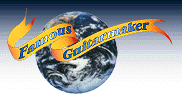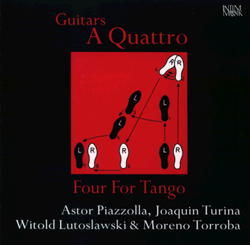
Featured Artist
December, 1997
 |
Famous Guitarmaker Internet World Headquarters Featured Artist December, 1997 |
Guitars A Quattro
"Four For Tango"
Matthias Aufschläger, Jörgen Åström, Urs Mayr, and Bernhard Wullschleger
 | Astor Piazzolla (1921-1992), the Argentinean bandoneón performer and composer, began to receive attention outside the Americas as late as during the 1980s. In recent years, however, he has come into fashion as a composer. This late recognition is reflected in the large number of recordings of his music, both in their original versions and as arrangements. |
|
This "King of the Tango" studied classical composition under Latin American masters such as Alberto Ginastera, and was greatly influenced by his studies in Paris in 1954 under the legendary Nadia Boulanger. She advised Piazzolla to concentrate on and to develop the tango, a dance form generally regarded as having its origins in the brothels of Buenos Aires at the turn of the century. Piazzolla himself, however, claimed that the tango was brought to Argentina from Mediterranean countries by Italian and Spanish immigrants. Under the particular influence of Bach, Stravinsky, bartók and possibly Gershwin, as well as jazz artists such as Duke Ellington, Charlie Parker and Miles Davis, Piazzolla went on to advance the Tango into the direction of the sophisticated Tango Nuevo, a form intended to be listened to rather than to be danced to. During his career he established several ensembles, comprising of five to eight musicians. Many of their live recordings are available on compact disc, and serve as significant musical documents today. Piazzolla wrote compositions and arrangements for these ensembles, in which he also played the bandoneón, the specifically Argentinean variation on the accordion. Piazzolla's oeuvre also includes a large number of pieces that are not in the Tango Nuevo genre. One of them is "Coral" and another, at least in some respect, is "Libertango", both of which are included in this Compact disc. Piazzolla's original work for guitar is relatively small, but many of his other compositions have proved to be well suited and very attractive as arrangements for one or more guitars. "Four, for Tango" was originally composed for traditional string quartet. The pieces by Piazzolla on this disc are arrangements for three guitars and bass guitar. Jörgen Åström and Matthias Aufschläger, who have arranged these pieces, have based their work on compositions originally written for various constellations ranging from solo instruments to Tango ensembles of three or five, and even for full orchestra. "Adios Nonino" may be Piazzolla's best known work. He wrote it in memory of his father, an Italian emigrant, who died in Argentina in 1958. He was known to his children as "nonino", the Italian word for grandfather. Verano Porteño is the first piece in a suite for the seasons, a collegial greeting to Vivaldi, whose well-known violin concert is collectively known as The Four Seasons. Verano means summer, and portend, refers to the harbour in Buenos Aires. The low tonalities create a feeling of stifling summer heat. The chromatic interval that dominates the introductory melody is extremely characteristic of Piazzolla, and recurs regularly in his compositions. Federico Moreno Torroba (1891-1982) made his name in the mid 1920s when he wrote his first zarzuela, a Spanish variation on the operetta. His oeuvre contains nearly 80 zarzuelas in all, many of which have been performed thousands of times, mainly in Spain and Latin America. In other parts of the world however, Moreno Torroba is best known for his guitar compositions. He composed over one hundred. He is regarded as a contemporary classic name in the history of music for the guitar, and it is often mentioned that Moreno Torroba wrote the very first commissioned piece for his contemporary, Andrés Segovia, in 1918. At that point Segovia was known only in his native Spain. Both Moreno Torroba and Segovia later contributed to raising the reputation of classical guitar music to its current height. Many of Torroba's colourful compositions for the guitar are suites comprising short pieces, like "Estampas", originally written for four guitars. Like Debussy's piano suite with the same title, it refers to the copper etchings or little prints, often of Japanese origin, that were so inspirational to impressionist artists and composers. The first movement performed here, "La Siega", portrays a harvest scene, and the melody quotes a Spanish folk song, followed by a sensitively described sunrise, "Amanacer". The final musical portrayals describe a wedding "La Boda," the way to the mill, "Camino del Molino", and playing children, "Juegos infantiles". Joaquin Turina (1882-1949) was born in Seville. Despite the fact that he moved to Madrid to study at the age of twenty, and later to Paris, as a composer he always identified himself as Andalusian. The rhythms and harmonics of Andalusia permeate his compositional style. However impressions of Céasr Franck and Debussy are also audible even in his early pieces, where echoes of flamenco music can sometimes also be detected. Turina did not write many pieces for the guitar, but he was one of the first composers to write for Segovia, and was greatly esteemed by him. Turina did express his admiration fir the Spanish national instrument in other contexts, such as his first string quartet, opus 4, "De la Guitarra" (1911). One of the themes of the quartet is based on the notes of the open strings of the guitar. The first movement is entitled "Prelude", and is performed here in an arrangement for four guitars by Matthias Aufschläger. Turina's second string quartet was actually a new version of an earlier quartet for four lutes entitled "La Oraciòn del Torero" (The Toreador's Prayer) from 1925. The Spanish laud bears very little similarity to the Renaissance or Baroque lute, but is a folk instrument more closely related to the bandurria, with six pairs of steel strings tuned to the same intervals as the guitar. This Iyrical, slightly sentimental piece is performed here in an arrangement fir three guitars and bass guitar by Jörgen Åström. In the immediate post-war years, Witold Lutoslawski (1913-1996) was on the staff of Radio Poland, where he made his living by composing a great deal of music fir everyday purposes, including children's music, theatre music etc., and even pop songs and light music which he wrote under a pseudonym. Parallel to composing this functional music, he worked on his first symphony, and in 1945 he wrote "Melodie ludowe" (Folk songs) for piano for the national Polish Music Publishing Company. Lutoslawski took twelve folk songs from different regions in Poland from an unpublished collection of songs of popular origin. He provided these simple diatonic melodies with more complex accompaniments. His harmonies also reflect elements of the music he was composing during this early period. Melodie ludowe was not actually intended for concert performance. The pieces were so simple that they could be played by moderately advanced pianists. A decree from the Polish Ministry of Culture made these pieces compulsory studies at the schools in Poland. Later Lutoslawski arranged some of these twelve unpretentious, charming folk songs for string orchestra; in addition he also arranged some for four violins. Matthias Aufschläger used both these arrangements and the original for piano for the arrangements on this disc for two, three or four guitars, sometimes also with a bass guitar. P-G Bergfors Translated from Swedish by: Linda and Robert Schenck Guitars A Quattro use La Bella strings exclusively. Thanks to ABB for the "Gartensaal", La Bella Strings, Paulino Bernabe in Madrid The attraction of the guitar has not been fully exhausted yet. Founded in Bern/Switzerland in 1989, Guitars A Quattro's main interest is to perform music of our century. Concentrating on contemporary music an working together with different composers, who have dedicated compositions to Guitars A Quattro, has let the ensemble to develop and explore new possibilities of variations in articulation and coloration. The playing of four guitars is transparent and analytical together with the warm coloration which is so typical of this instrument. This music, recorded with passion and knowledge of style, has received a new and utterly fascinating meaning. Translated from German by Pat Aeschbach Der Reiz der Gitarre ist noch lange nicht ausgeschöpft. 1989 in Bern/Schweizgegründet, setzt das Ensemble konsequent die Idee ins Zentrum, Musik unseres Jahrhunderts aufzuführen. Mit verschiedenen Komponisten, deren Gitarrenwerke Guitars A Quattro gewidmet sind, entstand eine fruchtbare Zusammenarbeit. Die Auseinandersetzung mit moderner Musik eröffnet grosse Variationsmz7ouml;glichkeiten in Arikulation und Farbgebung. Das Zusmmenspiel der vier Gitarren klingt transparent und analytisch mit dem für das Instrument typischen warmen Kolorit. Die hier eingespiche Musik gelangt so zu neuen, äusserst reizvollen Aussagen. Guitars A Quattro ü usserst reizvollen Aussagen. Guitars A Quattro überzeugt mit stilsicheren und leidenschafilichen Interpretationen. THE SELECTIONS: Astor Piazzolla
Estampas
| |
|
Recorded at Gartensaal, Villa Boveri | |
© Intim Musik © 1996
Box 8057, 424 12 Olofstorp, Sweden
Tel. 031-702 06 46
Fax 031-702 52 96
Directory of our 1995, 1996, 1997, 1998 featured recording artists.
© famous guitarmaker
internet world headquarters site
maintained by cyboboy@cybozone.com